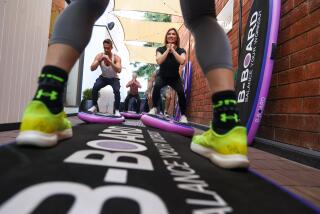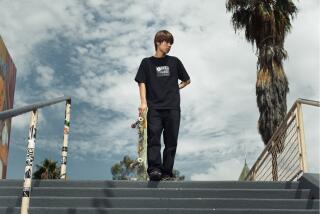Hang Gliders Relive Early Days of Their Sport
- Share via
The men and women stood on the bluff in admiration of flight. Not the flight of planes or birds, but of people who fly without the gift of wings or the burden of engines.
This group of hang gliders--including the pioneers of the sport--gathered Saturday at Dockweiler State Beach for a reunion celebrating three decades of flying over these local sands.
Amid old photos, colorful vintage hang gliders and the latest models, they reflected on the sport’s long history, the design advances that have changed it, and the irrepressible urge to be airborne that unites them.
“It’s just that fascination with the air, the desire to be part of the air, to feel the texture of the air, that motivates us,” said Taras Kiceniuk Jr., 46, a major figure in hang gliding, who started as a teenager and designed his own models.
So much hang gliding history resides at Dockweiler that the stories the pioneers tell of first flights and design discoveries often begin on this bluff. Last year, a portion of the beach opened as a hang gliding park after much work by the sports practitioners who spent years urging government officials to give them a local facility.
The completion of the park is part of $6 million in improvements at Dockweiler State Beach Recreational Facility that also upgraded bike paths and built restrooms and concession stands.
On Saturday, a representative from the office of Los Angeles City Councilwoman Ruth Galanter presented a resolution, honoring the hang gliders “for their commitment to establishing what we know of as the only hang gliding park established in partnership with city government,” said Viet Tran, Galanter’s deputy for Westchester and Playa del Rey. “We’re very proud of them.”
In many ways, the long history of hang gliding at Dockweiler is the story of the sport itself. It thrived here, was banned for 13 years, then was brought back last October.
“Hang gliding was pretty much born in Southern California,” said Joe Greblo, a hang gliding instructor who led the effort to bring hang gliding back to the state beach. “What that meant was that it had its growing pains here as well. Every new sport has its problems that take time to overcome.”
Dating to the ‘60s and even earlier, according to some histories, Dockweiler earned the distinction as a prime spot for hang gliding. With gentle breezes, soft sands and small hills, a novice could strap into the hang glider, run off a cliff, fly and land in the most forgiving ground possible.
That generosity of the elements was crucial, because in those early days, hang gliders were not just practitioners of the sport; they were creators.
The park today makes for an ideal setting for beginners, who for about $59 get a lesson, a rental glider and within an hour fly off a bunny hill.
On Saturday, a long line of people cued up to shake hands with Richard Miller, 76, considered the grandfather of hang gliding.
“He was the one that made the rest of us think it was possible,” said 65-year-old Frank Colver, who began hang gliding 26 years ago and created an instrument that measures a glider’s rate of climb.
Miller grew up in a generation that was fascinated with flight. There were many aviation magazines then, and he read them and made a promise: “When I grow up, I’ll build myself a hang glider.”
In 1966, Miller flew a hang glider that he had designed and created using bamboo and plastic. Then he shared his designs with others.
Even then, Miller envisioned some of the changes that would come--the brightly colored crafts, the young people.
Kiceniuk was 17 when he made his hang glider--after reading a magazine and ordering Miller’s plans. The teenager and his buddies refined the plans, made the craft and learned--to their joy--that they could fly.
That effort eventually landed him in the February 1972 issue of National Geographic, which covered a historic gathering of hang gliders, dubbed the Otto Lilienthal, after the German designer on whose birthday the event was held.
But the sport had another side that permeated the public’s perception.
“Everybody involved in hang gliding had friends who were killed in the sport. Everyone did,” Kiceniuk recalled. “That was the alarming thing about hang gliding in those days, and one of the reasons a lot of people phased out of the sport.”
Many of the pioneers stayed with it--improving glider design and the sport’s safety record. Kiceniuk became an engineer, designing his own crafts and working with a historic group that won a British prize--50 pounds--for creating the first human-powered craft in the ‘70s.
Greblo, who started hang gliding at Dockweiler when he was 21, continued hang gliding and teaching others at the beach. But by 1986, officials had grown concerned about safety and other issues, including liability, parking and the possibility of hang gliders colliding with bikers on a path below the bluff. Eventually, the spot was closed to hang gliders.
For the next 13 years, Greblo lobbied, wrote letters and reports, and pushed and prodded to bring the sport back. Insurance was a big issue. The sport still reeled from a record that included deaths and injuries.
But without access to a training facility like Dockweiler, the sport suffered, enthusiasts say. People were forced to drive farther and to learn in areas that were not nearly as forgiving as Dockweiler.
The return of hang gliding means there probably will be more people attracted to the sport, said Greblo, who won a contract from the county to run the hang gliding school at Dockweiler.
On Saturday, his staff taught the nephew and son of Pete Plumb, who made his first hang glider when he was 15--using plans he had ordered from Miller.
Plumb stood with a video camera as his 15-year-old son Nick and his 19-year-old nephew, David, took their first flights Saturday morning.
Each strapped in, then listened as the instructor taught them to run, then glide with a light touch.
“You start running, and all of a sudden your feet are off the ground,” David Plumb said after his first flight.
“I think it was a good first flight.”
His cousin Nick added, “It’s the closest thing to being a bird.”
More to Read
Sign up for The Wild
We’ll help you find the best places to hike, bike and run, as well as the perfect silent spots for meditation and yoga.
You may occasionally receive promotional content from the Los Angeles Times.






